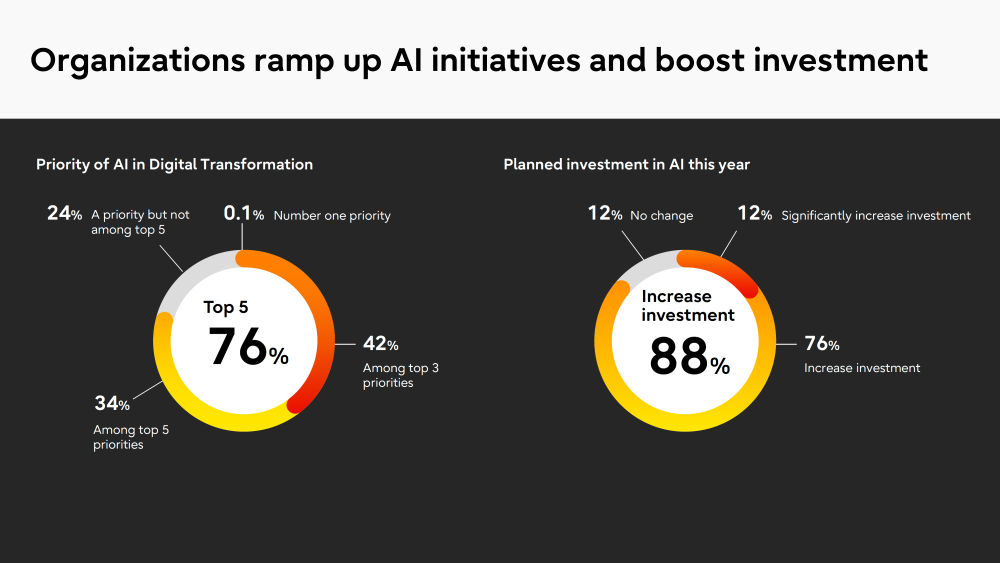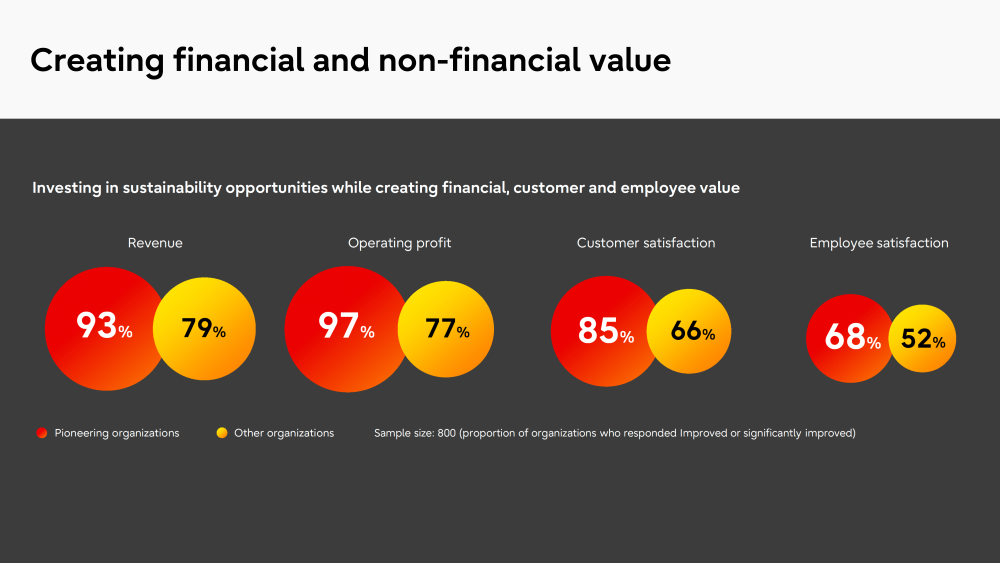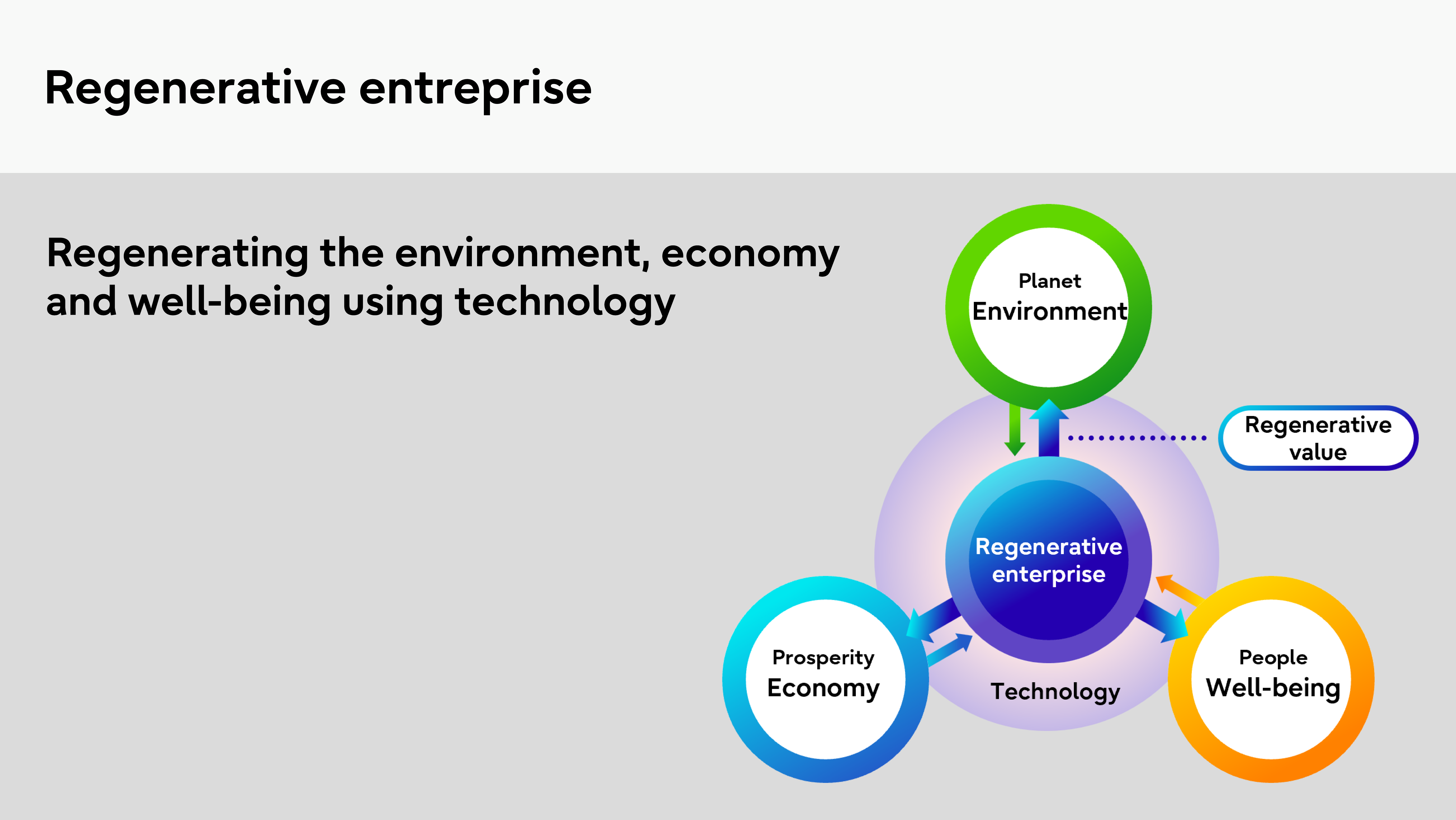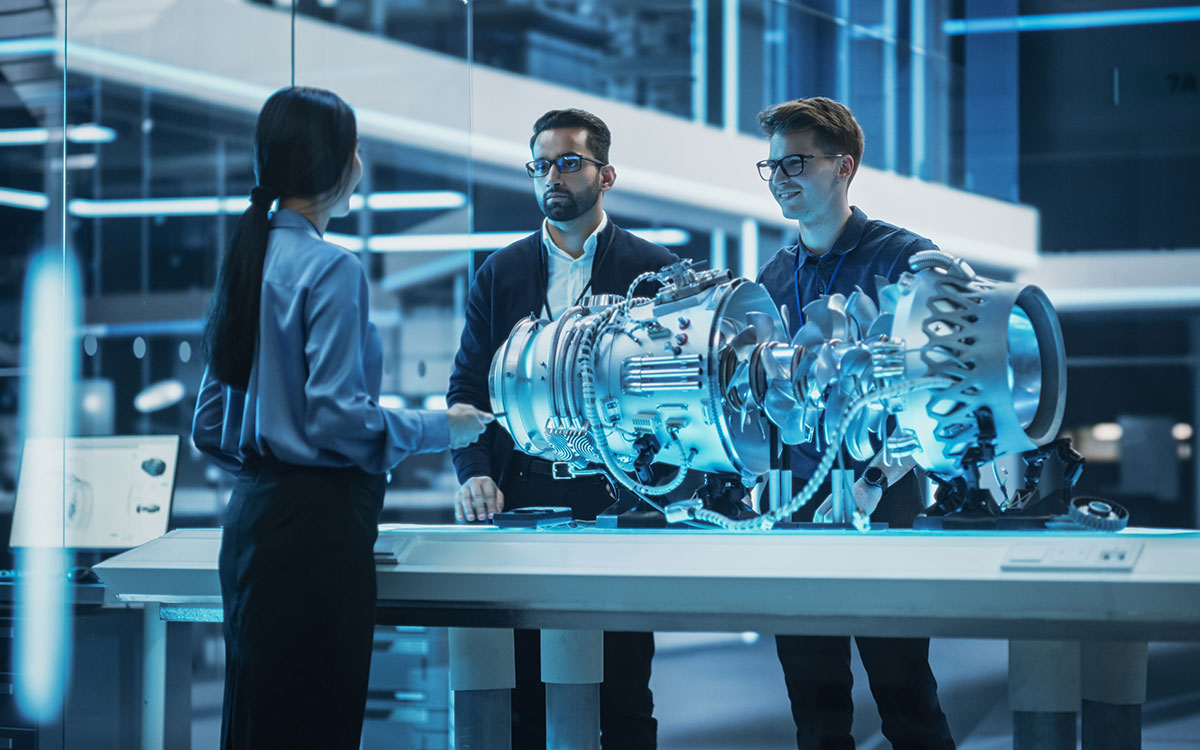AI-driven transformation: A synergistic path to sustainability and profitability
Fujitsu / November 20, 2024
In today’s rapidly changing business environment, sustainability has evolved from a mere checkbox to a crucial strategic priority. Environmental, Social, and Governance (ESG) factors are fundamentally reshaping how companies operate, influencing investor decisions, consumer preferences, and regulatory frameworks. Interestingly, businesses no longer see a dichotomy between sustainability and business growth. In fact, Fujitsu surveyed 800 business leaders about their thoughts on this topic, and more than half agreed that it is important to achieve business growth while contributing to environmental and social sustainability.
At the same time, businesses and society are undergoing significant transformations due to the rapid evolution and adoption of technological advancements such as AI. Our survey reveals that pioneering organizations use key technologies such as AI to not only cut costs and improve efficiencies, but also deliver value back to the planet, improve people’s wellbeing and ensure a prosperous digital society. We call these organizations "regenerative enterprises."
Drawing on our research findings and our extensive experience with customers worldwide, this blog discusses practical steps for how AI can help organizations enhance profitability, while also contributing towards their Sustainability Transformation efforts.
AI adoption: where we stand and where we’re headed
AI has become a top priority for many organizations, with 76% ranking it among their top 5 priorities for digital transformation. Furthermore, a significant majority (88%) of organizations are planning to increase their investments in AI in the next 12 months. This suggests that AI is seen as a crucial driver of growth and innovation for businesses moving forward.
At present, AI is predominantly used to automate customer services and other routine tasks supported by Generative AI. For example, a large automotive customer is exploring using Fujitsu Kozuchi Generative AI to empower their customer service department. They fed the chatbot model with numerous car manuals, empowering their support desk personnel to answer a wider variety of support questions faster, thus raising employee productivity as well as their well-being.
Predictive AI is also being used to enhance management decision making. For instance, AI is very valuable for demand and supply forecasting. With more reliable forecasts, organizations can reduce wastage, which not only improves margins, but also leaves a lower environmental footprint.
But there are still untapped opportunities for AI to bring in greater efficiencies with solutions across different sectors and functions. Gradually, we will be seeing increasing usage of AI for more complex stuff, like enhancing product functionalities, R&D, and supply chain, etc.
Fujitsu has already been helping many pharmaceutical companies accelerate their Drug Discovery processes helping to cut down what is mainly a decade long process, to just a few years.
Clearly, the best of AI’s potential is yet to come for many industries and companies. However, this raises the concerns about AI automating away human jobs.

AI and the workforce: adapting to change
While some companies believe AI will boost productivity without cutting jobs, others worry it might automate certain roles entirely. This raises the critical question: "Will AI be our partner or our replacement?" Rather than viewing AI solely as a replacement, many organizations are exploring ways to integrate it into their operations and helping their employees do their jobs more creatively and productively.
For instance, the Aichi Cancer Centre in Japan, in collaboration with Fujitsu, uses AI with Knowledge Graphs to suggest cancer drug candidates based on genetic mutations. This empowers doctors to develop better treatment plans. Similarly, a large university is utilizing Fujitsu Kozuchi AutoML to help research students generate machine learning code, allowing them to focus on data analysis rather than technical programming.
Our research also shows that over 60% of business leaders believe AI will enhance outputs while retaining staff, yet 40% still plan to reduce their workforce. This suggests a dual outcome: increased productivity for some tasks while others may be automated. People involved in such roles will inevitably need to focus on higher order skills such as critical thinking and creative problem-solving. Interestingly, organizations can also use AI itself to reskill employees.
One example is our research collaboration with Macquarie University, Australia, in developing a digital coaching technology using AI. Using human sensing and generative AI, we analyze workers’ behavior at a manufacturing site and automatically generate educational content focused on reducing common errors.

A statement from our interviews captures this dynamic: “AI does not take jobs from people; organizations that use AI will take jobs from those that do not.” This emphasizes the importance of accelerating AI implementation to stay competitive in the future of work.
Barriers to wider AI adoption and Sustainability Transformation
While businesses do recognize AI’s potential, many companies are still stuck in the starting phases, with only 12% having established clear AI strategies and allocated resources for implementation. One of the most significant barriers is the skills gap; organizations need individuals who can not only understand AI but also keep pace with its rapid advancements. Additionally, concerns about copyright, return on investment, and data security persist. Organizations often struggle with integrating AI into existing data and IT frameworks, compounded by a lack of trust in AI systems.
Building trust in AI is also crucial, as we typically hold it to higher standards than human performance. To foster this trust, ethical considerations must be integrated from the outset. Solutions like anti-hallucination technologies and bias detection should be embedded into AI systems to ensure reliability and ethical use.
There’s also a strong connection between AI and successful sustainability transformation. We see that 76% of business leaders think that Digital Transformation will contribute to the success of their Sustainability Transformation. Specifically, more than half of the business leaders surveyed recognize that contributing to sustainable energy use, reducing waste, promoting recycling, contributing to sustainable economic and industrial development are all important business opportunities. And they also see technologies such as AI as the key to realizing these opportunities. However, only 10% of organizations are generating steady revenue from sustainability-related business ventures. There are a few reasons why this is the case:
• Complexity: Sustainability Transformation is quite complex and requires deep change across the whole company, not just about one department. It requires everyone to work together and requires strong leadership.
• Technology: Many organizations lack the right technological infrastructure to support such initiatives. You need systems that can track progress, analyze data, and help you make smart decisions.
• Data: Good, reliable data is crucial. For example, many can monitor Green House Gas emissions within organizations, but face difficulty in collecting data across the whole value chain.
• Business Cases: It's tough to convince everyone that sustainability is good for business. Sustainability is a long- term investment and may negatively affect the bottom line in the short term.
Given these challenges, the journey toward sustainability transformation is complex, but many leaders believe that advancements in AI can help accelerate this essential shift.

The path forward: AI-driven Sustainability Transformation and business growth
The potential of AI for Sustainability Transformation is limited only by our imagination. AI can help us understand climate change better, design more efficient energy systems to contribute to carbon neutrality, and even mitigate the damaging effects of natural disasters. For instance, in Kawasaki city, Japan, together with research institutes and universities, we have developed an AI model using our supercomputer Fugaku, that will enable near real-time prediction of tsunami flooding in coastal areas.
AI can also be a driver of business growth, while also being solving societal problems. For instance, we’ve all read about A.P. Moller Maersk using AI to decarbonize their entire global supply chain, working with suppliers, vendors, and customers to reduce their environmental impact. This is a great example of how AI can be used to create a more sustainable ecosystem.
Our research reveals pioneering companies are achieving better financial and non-financial performance by building businesses that are both profitable and sustainable.

To become such “regenerative enterprises” driving Sustainability Transformation with AI, we encourage organizations to:
• use AI to enhance human capabilities and well-being,
• develop and implement a comprehensive AI strategy and guidelines,
• leverage AI to address sustainability challenges,
• strengthen their organizational capabilities to engage in sustainability as a core business function,
• and build cross-industry ecosystems focused on sustainability.

Getting Started
For more information on the research underpinning this blog, we recommend checking out the full survey report “2024 Fujitsu SX Survey - Accelerating Sustainability Transformation with AI.” Readers may also be interested in the Fujitsu Technology and Service Vision to understand the sustainable future we aspire to co-create, using technology, with our customers and partners. We also encourage readers to check out the Fujitsu Research Portal, an exciting new environment to test Fujitsu’s advanced technologies rapidly and free of charge, including Fujitsu Kozuchi AI. Links to all of the above are included in the ‘Related information’ section.

Throughout 27 years of his career at Fujitsu, Hiroshi has acquired a deep knowledge of technology, from communication to computing, and gained broad international experience including five years based in Germany. He has also led strategic initiatives such as partner alliances and M&A, driving Fujitsu's business to grow. Today Hiroshi uses his experience of business and technology to engage with a wide range of customers and partners around the world.

After a specialization in outsourcing and IT managed services, Valérie has developed some of Fujitsu's most valuable partner relationships and is now responsible for its Sustainability strategy and go-to-market programs.
Related information
- https://activate.fujitsu/en/about/vision/technology-vision/leadership-challenges/sustainability-transformation-survey-2024
- https://activate.fujitsu/en/about/vision/technology-vision
- https://en-portal.research.global.fujitsu.com/
- https://activate.fujitsu/en/key-technologies/ai/
- https://www.fujitsu.com/global/kozuchi
Editor's Picks







